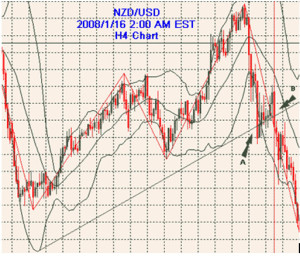H4 Bollinger Band Breakouts Strategy – How to Identify Breakouts
Full Review of the H4 Bollinger Band Breakouts Strategy
This is a Bollinger band strategy that uses trend-lines to identify breakouts of the upper and the lower band. I read about it on http://forex-strategies-revealed.com/ but it’s originally from RPchost.com, created by Joe Chalhoub. The description was quite confusing, I had trouble figuring out how and where to draw the trend-lines and what exactly I should look for. After a lot of trial and error I finally got it! The comments at the end of the strategy were helpful in deciphering the strategy but it still leaves a lot to be desired.
What is The H4 Bollinger Band Break Out Strategy?
The H4 Bollinger Band Break Out strategy is a short term strategy focusing on a single indicator but utilizing two time frames. It uses the Bollinger Band indicator set to (20) with the center signal line included and targets entry on a break out. It takes trends into consideration and even uses the Bollinger Bands for that. First you need to draw a line connecting two points on either the upper or the lower Bollinger band on the H4. If price is going up; draw a line under the lower Bollinger band connecting two points. If price is going down; draw a line over the upper Bollinger band connecting two points. This sets the trend. Next thing you should look for is a breakout. This happens when a H4 candle breaks above or below your trend-line. As soon as a candle has broken the trend-line, go to the H2 timeframe. On the H1 you should still be able to see the trend-line that you drew on the H4, the center line of the H1 Bollinger band should be breaking the trend-line drawn on the H4 bands. If it’s not breaking it, then it’s not a valid point of entry and you should go back to the H4 chart and wait for another signal. Breaking the trend-line via the lower band means you would take a Put and vice versa for Calls.
This is how it works:
To start, use the H4 timeframe and draw a trend-line connecting the lower tops or higher bottoms that the upper Bollinger band creates. If prices are moving lower and the Bollinger bands create lower highs, you will be looking to trade calls on a break of resistance, the trend-line drawn between the two lower peaks. If the asset is moving higher you draw your line between the troughs and will be trading puts on a break below this support.
The Required Setup
Indicator: Bollinger Band (20) with the center-band visible.
Timeframe: H4 and H2
Currency: Any
Expiry: Not mentioned

Why Does this Strategy Suck?
The first issue with this strategy is, as the author himself points out, the false breakouts. It can be very difficult knowing which breakout is a fake. The center B-band can break your trend-line in the desired direction resulting in you entering a trade only for it to break back to where it was moments later. Another issue is trading against the trend, I don’t want to stack the odds against myself when I trade. This is a pure counter trend strategy, trading reversals. I also believe this strategy needs something else in addition to the BB-breakouts and trend-lines, price action for example. Furthermore, drawing the trend-lines can be difficult, even a slightly misplaced line can change the entire outcome of your trade – you will get in too late or too early.
Why Doesn’t this Strategy Suck?
Bollinger bands and the EMA (center B-band) used correctly are great indicators. You can verify a trend or a tunnel quite easily with the help of the Bollinger band. This strategy will definitely point out a few breakouts here and there which can actually turn out well, especially when used in combination with other strategies and indicators.
Conclusion – Might be Too Complicated for the Average Joe
I think you can avoid some of the false breakouts if you only take the ones that happen IN the direction of the trend and ignore the others. This could be difficult and may mean that the signals will not trigger very often. Adding price action, support and resistance lines, will for sure increase the accuracy of your entries. Furthermore, a shorter timeframe may be the ticket when using this strategy. My personal experience suggests that an H2/M5 combination works well. You should test both H4/H1 and the H1/M5 to see which timeframe gives the most frequent and accurate signals.
My final thought is that this strategy is too complicated and does not keep things simple, therefore I can’t recommend it. Going through so much trouble when you can simply use trend-lines to trade with the trend, instead of against it, is unnecessary.